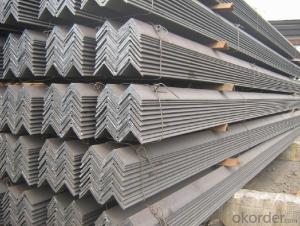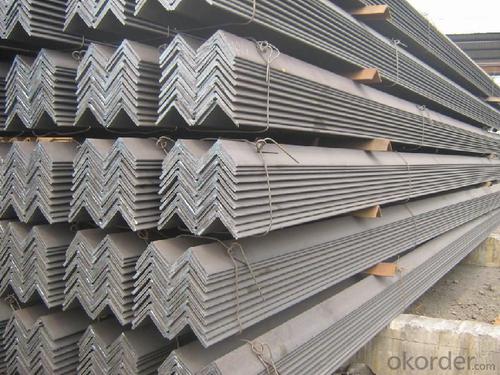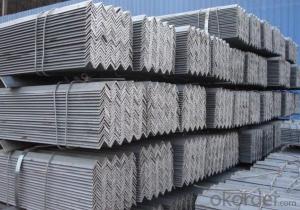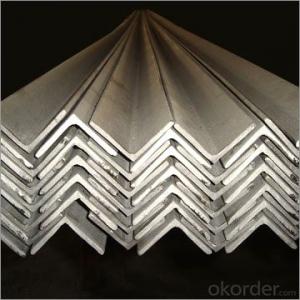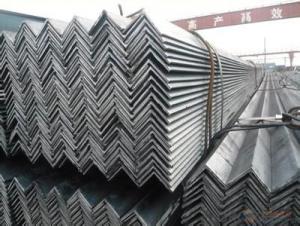High Quality Angle Steel 20-25mm Hot Rolled GB Q235
- Loading Port:
- Tianjin
- Payment Terms:
- TT or LC
- Min Order Qty:
- 25 m.t.
- Supply Capability:
- 20000000 m.t./month
OKorder Service Pledge
OKorder Financial Service
You Might Also Like
Product Description:
OKorder is offering high quality Hot Rolled Steel I-Beams at great prices with worldwide shipping. Our supplier is a world-class manufacturer of steel, with our products utilized the world over. OKorder annually supplies products to European, North American and Asian markets. We provide quotations within 24 hours of receiving an inquiry and guarantee competitive prices.
Product Applications:
According to the needs of different structures, Angle can compose to different force support component, and also can be the connections between components. It is widely used in various building structures and engineering structures such as roof beams, bridges, transmission towers, hoisting machinery and transport machinery, ships, industrial furnaces, reaction tower, container frame and warehouse etc
Product Advantages:
OKorder's Steel I-Beams are durable, strong, and resist corrosion.
Main Product Features:
· Premium quality
· Prompt delivery & seaworthy packing (30 days after receiving deposit)
· Corrosion resistance
· Can be recycled and reused
· Mill test certification
· Professional Service
· Competitive pricing
Product Specifications:
Manufacture: Hot rolled
Grade: Q195 – 235
Certificates: ISO, SGS, BV, CIQ
Length: 6m – 12m, as per customer request
Packaging: Export packing, nude packing, bundled
Sizes: 25mm-250mm | ||||||||||||
a*t | ||||||||||||
25*2.5-4.0 | 70*6.0-9.0 | 130*9.0-15 | ||||||||||
30*2.5-6.6 | 75*6.0-9.0 | 140*10-14 | ||||||||||
36*3.0-5.0 | 80*5.0-10 | 150*10-20 | ||||||||||
38*2.3-6.0 | 90*7.0-10 | 160*10-16 | ||||||||||
40*3.0-5.0 | 100*6.0-12 | 175*12-15 | ||||||||||
45*4.0-6.0 | 110*8.0-10 | 180*12-18 | ||||||||||
50*4.0-6.0 | 120*6.0-15 | 200*14-25 | ||||||||||
60*4.0-8.0 | 125*8.0-14 | 250*25 | ||||||||||
FAQ:
Q1 How do we guarantee the quality of our products?
A1 We have established an advanced quality management system which conducts strict quality tests at every step, from raw materials to the final product. At the same time, we provide extensive follow-up service assurances as required.
Q2 How soon can we receive the product after purchase?
A2 Within three days of placing an order, we will begin production. The specific shipping date is dependent upon international and government factors, but is typically 7 to 10 workdays.
Q3 What makes stainless steel stainless?
A3 Stainless steel must contain at least 10.5 % chromium. It is this element that reacts with the oxygen in the air to form a complex chrome-oxide surface layer that is invisible but strong enough to prevent further oxygen from "staining" (rusting) the surface. Higher levels of chromium and the addition of other alloying elements such as nickel and molybdenum enhance this surface layer and improve the corrosion resistance of the stainless material.
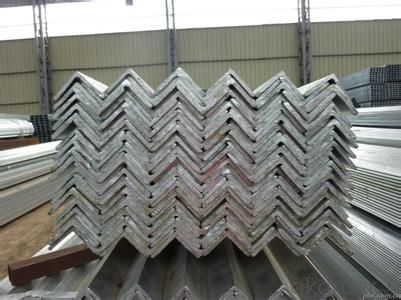
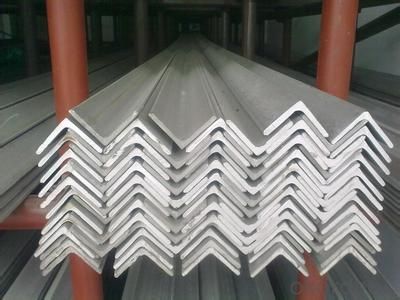
- Q: How are steel angles used in structural framing?
- Steel angles are commonly used in structural framing to provide support and stability to various building components. These angles, which are L-shaped, are used to connect and reinforce different elements of a structure, such as beams, columns, and trusses. One of the main uses of steel angles in structural framing is to provide additional strength and rigidity to beams and columns. By attaching steel angles to the sides of these components, the angles act as braces, preventing the beams or columns from buckling or bending under heavy loads. This is particularly important in large-scale construction projects, where the structural integrity of the building is crucial. Steel angles are also used to create connections between different structural members. For example, they can be used to connect beams to columns, providing a secure and stable joint. The angles are typically bolted or welded to both members, creating a strong and durable connection. Additionally, steel angles can be used to create framing for walls, roofs, and floors. By attaching angles to the top and bottom of these components, a rigid framework is formed, which can support the weight of the structure above and provide stability during construction. In summary, steel angles play a vital role in structural framing by providing support, reinforcing connections, and creating stable frameworks. Their versatility and strength make them an essential component in the construction industry.
- Q: What are the different types of steel angles used in engineering?
- Engineering incorporates a range of steel angle varieties that enjoy common usage. These angles are typically fashioned from hot-rolled steel and come in various sizes and dimensions to suit diverse applications. Within engineering, different steel angle types are employed, including: 1. Equal angles: These angles boast identical sides and are frequently utilized for structural purposes, like supporting beams or columns. They furnish stability and strength to the structure and are commonly employed in construction ventures. 2. Unequal angles: As the name suggests, unequal angles feature sides of differing lengths. These angles are often employed in situations where one side must be longer or shorter than the other, such as bracing or framing. 3. L-shaped angles: L-shaped angles possess one side longer than the other, forming an L shape. They are frequently used in construction to offer support and reinforcement, particularly for corners, joints, or connections. 4. Structural angles: Structural angles are specifically designed to bear heavy loads and confer structural stability. They are commonly deployed in constructing frame structures, bridges, or other load-bearing applications. 5. Stainless steel angles: Stainless steel angles are fabricated from stainless steel, which delivers excellent corrosion resistance and durability. These angles are often employed in environments where rust or corrosion may be a concern, such as marine applications or food processing facilities. 6. Galvanized steel angles: Galvanized steel angles are coated with a layer of zinc to provide corrosion resistance. These angles are commonly used in outdoor applications or environments where exposure to moisture or harsh conditions is expected. 7. Perforated steel angles: Perforated steel angles feature holes or perforations along their length, facilitating enhanced ventilation or drainage. These angles are frequently employed in situations where airflow or water drainage is required, such as in HVAC systems or outdoor structures. Overall, the selection of a steel angle hinges upon the specific requirements of an engineering project. Factors such as load-bearing capacity, resistance to corrosion, and aesthetic considerations play a crucial role in determining the appropriate type of steel angle for a particular application.
- Q: How do you protect steel angles from chemical exposure?
- To protect steel angles from chemical exposure, there are several measures that can be taken: 1. Coatings: Applying protective coatings such as epoxy, polyurethane, or powder coatings can create a barrier between the steel surface and the chemicals. These coatings are specifically designed to resist chemical attacks and provide long-term protection. 2. Galvanization: Galvanizing steel angles involves applying a layer of zinc to the surface, forming a protective barrier. This process not only protects against chemical exposure but also provides excellent corrosion resistance. 3. Chemical-resistant paint: Using chemical-resistant paint, specifically formulated to withstand exposure to certain chemicals, can provide an added layer of protection. These paints are designed to resist the corrosive effects of various chemicals and prevent damage to the steel angles. 4. Plastic or rubber linings: In some cases, steel angles can be lined with plastic or rubber materials to protect them from chemical exposure. These linings act as a barrier, preventing direct contact between the steel and chemicals. 5. Proper ventilation: Ensuring proper ventilation in the area where steel angles are exposed to chemicals is crucial. Adequate ventilation helps to disperse and dilute the chemicals, reducing the overall exposure and minimizing the corrosive effects on the steel angles. 6. Regular inspection and maintenance: Regularly inspecting the steel angles for any signs of corrosion or damage caused by chemical exposure is vital. If any damage is detected, it should be repaired promptly to prevent further deterioration. It is important to note that the choice of protection method may vary depending on the type of chemicals involved, their concentration, and the specific environment in which the steel angles are exposed. Consulting with a professional or a corrosion specialist is recommended to determine the most suitable protection strategy for a particular application.
- Q: How do you protect steel angles from weathering?
- To protect steel angles from weathering, there are several effective methods that can be employed. The most common approach is to apply a protective coating or paint specifically designed for steel surfaces. This coating acts as a barrier, preventing moisture and oxygen from coming into direct contact with the steel and thus reducing the chances of rust formation. It is essential to choose a coating that is weather-resistant and provides long-term durability. Before applying the protective coating, it is crucial to thoroughly clean the steel angles to remove any dirt, grease, or existing rust. This can be done through abrasive cleaning methods such as sandblasting or using a wire brush. After cleaning, the surface should be primed with a corrosion-resistant primer, which enhances the adhesion of the protective coating. Regular maintenance is also essential to ensure the ongoing protection of steel angles from weathering. This includes inspecting the coating periodically for any signs of damage or wear and promptly addressing any issues that arise. Touching up areas where the coating has been compromised is necessary to maintain the integrity of the protective layer. Moreover, proper design and installation techniques can also contribute to protecting steel angles from weathering. Ensuring that the angles are adequately sealed and protected from direct exposure to rain, snow, or other moisture sources is vital. This can be achieved through proper drainage systems, such as gutters or downspouts, to redirect water away from the steel angles. Lastly, considering alternative materials or coatings that are inherently resistant to weathering, such as stainless steel or galvanized steel, can provide an added layer of protection against environmental elements. These materials have a higher resistance to corrosion and are more suitable for outdoor applications where weathering is a concern. By implementing a combination of protective coatings, regular maintenance, proper design, and utilizing weather-resistant materials, steel angles can be effectively protected from weathering and maintain their structural integrity over an extended period.
- Q: Can steel angles be used in curtain wall construction?
- Yes, steel angles can be used in curtain wall construction. Steel angles are commonly used as framing members in curtain wall systems to provide structural support and rigidity. They are typically used as mullions or transoms, which are the vertical and horizontal members that hold the glass panels in place. Steel angles are preferred due to their strength, durability, and ability to withstand the loads and stresses of the curtain wall system. Additionally, steel angles can be easily fabricated and installed, making them a popular choice in curtain wall construction.
- Q: How do you calculate the axial load capacity of a steel angle?
- To calculate the axial load capacity of a steel angle, you need to consider several factors including the material properties of the angle, its dimensions, the type of loading, and the safety factor. First, you should determine the yield strength of the steel angle. This value represents the maximum stress the angle can withstand without permanent deformation. The yield strength can be obtained from the steel angle's specifications or by conducting material testing. Next, you need to measure the dimensions of the angle, including its length, thickness, and width. These values are crucial in determining the area of the cross-section of the angle. Once you have the yield strength and the cross-sectional area, you can calculate the axial load capacity using the formula: Axial load capacity = Yield strength × Cross-sectional area It is important to note that this formula assumes that the angle is subjected to direct axial loading. If the angle is subjected to combined loading or other complex loading conditions, additional calculations or structural analysis may be required. Moreover, it is customary to apply a safety factor to the calculated axial load capacity to account for uncertainties and ensure structural integrity. The safety factor is typically determined based on the specific application and industry standards. For example, a safety factor of 1.5 is commonly used in structural design. In summary, to calculate the axial load capacity of a steel angle, you need to know its yield strength, measure its dimensions, and apply the appropriate safety factor. This calculation provides an estimate of the maximum load the angle can bear without failure under axial loading conditions.
- Q: Can steel angles be used for fencing and gate construction?
- Indeed, fencing and gate construction can make use of steel angles. The strength and durability of steel angles make them a prevalent choice in construction endeavors. They furnish robust frameworks for fencing and gate structures, delivering support and stability. The process of welding or bolting steel angles together is a simple means of achieving the desired shape and size for fencing and gate construction. Moreover, steel angles possess exceptional resistance to corrosion, rendering them suitable for outdoor applications. In summary, steel angles present themselves as a versatile and dependable option for fencing and gate construction.
- Q: What is the difference between hot-rolled and cold-rolled steel angles?
- The main difference between hot-rolled and cold-rolled steel angles lies in the manufacturing process. Hot-rolled steel angles are formed at high temperatures, making them less precise in terms of dimensions and surface finish. Cold-rolled steel angles, on the other hand, are formed at room temperature, resulting in more precise dimensions and a smoother surface finish. Additionally, hot-rolled steel angles are generally more cost-effective, but cold-rolled steel angles offer improved strength and durability.
- Q: How do you prevent steel angles from twisting?
- There are several methods that can be employed to prevent steel angles from twisting: 1. Proper fabrication techniques: Ensure that the steel angles are fabricated accurately and precisely, with straight and square cuts. This will help maintain the structural integrity of the angles and prevent them from twisting. 2. Bracing and supports: Use appropriate bracing and supports during the installation process to provide stability to the steel angles. These can include temporary supports, diagonal bracing, or cross bracing, depending on the specific application. 3. Welding techniques: When joining steel angles together, use proper welding techniques to minimize distortion and twisting. This includes using the correct welding process, ensuring proper heat control, and employing suitable fixturing to hold the angles in place during the welding process. 4. Anchoring methods: Depending on the specific application, anchoring methods such as bolting, screwing, or welding the steel angles to other structural elements can help prevent twisting. These anchoring methods provide additional stability and prevent the angles from rotating or twisting under external forces. 5. Regular inspections and maintenance: Conduct regular inspections to identify any signs of twisting or distortion in the steel angles. If any issues are detected, take immediate corrective action to rectify the problem and prevent further twisting. Overall, a combination of accurate fabrication, proper bracing and supports, appropriate welding techniques, anchoring methods, and regular maintenance can effectively prevent steel angles from twisting and ensure their structural stability.
- Q: Can steel angles be used for manufacturing handrails?
- Indeed, the utilization of steel angles is viable for the production of handrails. In the realm of construction and fabrication, steel angles are frequently employed owing to their robustness and endurance. These angles can be effortlessly manipulated and joined together through welding techniques to form diverse structures, including handrails. The angular form of steel angles furnishes stability and reinforcement, rendering them exceptionally suitable for handrail purposes. Furthermore, these steel angles can undergo galvanization or coating processes to augment their resistance against corrosion, thereby guaranteeing the longevity and security of the handrails.
Send your message to us
High Quality Angle Steel 20-25mm Hot Rolled GB Q235
- Loading Port:
- Tianjin
- Payment Terms:
- TT or LC
- Min Order Qty:
- 25 m.t.
- Supply Capability:
- 20000000 m.t./month
OKorder Service Pledge
OKorder Financial Service
Similar products
Hot products
Hot Searches
Related keywords
